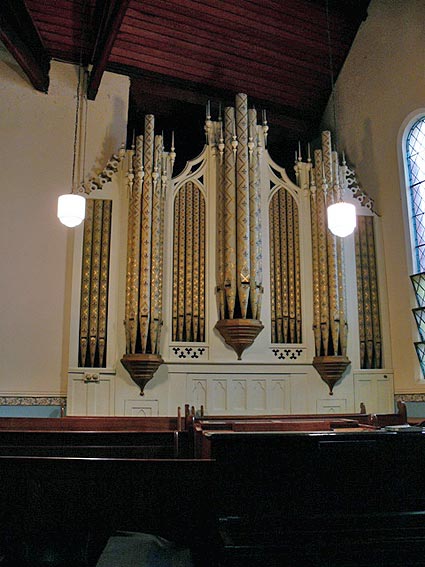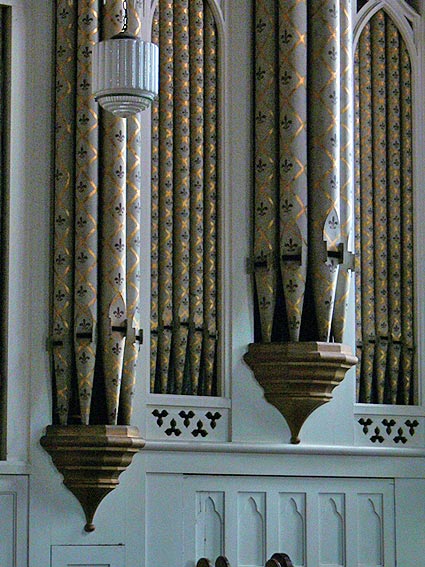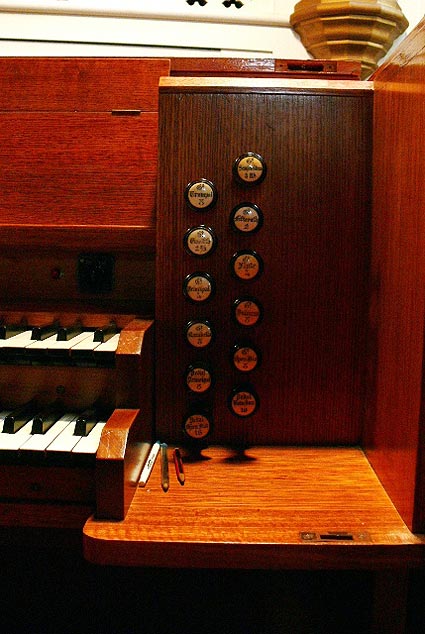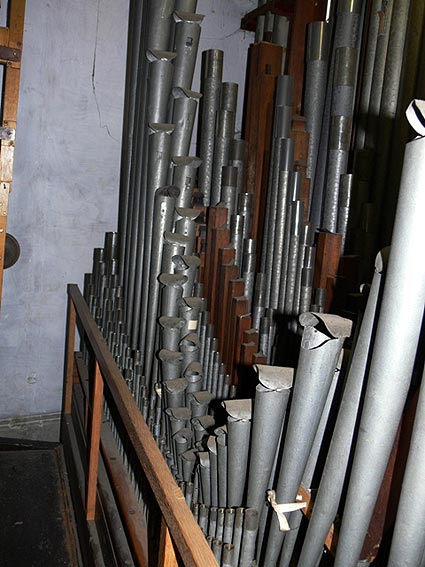Kooyong Road, Armadale
B 1877 George Fincham for Baptist Church, Albert Street, Eastern Hill, Melbourne;
installed present location 1904. Restored 1971 Laurie Pipe Organs.
2 manuals, 22 speaking stops, 3 couplers, tracker & electro-pneumatic action.

The foundation stone of the Armadale Baptist Church was laid on 20 July 1898. The architects were Sydney Smith & Ogg and the builder A. Parker. It was designed in an advanced Romanesque style in red brick with stucco dressings, dark brick diapering, chequerboard gable treatment and fleche on the roof ridge. The building was later linked with the hall, in the same style. The church retains its original timber fittings, sloping floor and stained glass.
The organ was built in 1877 by George Fincham for the Baptist Church, Albert Street, East Melbourne (the façade of which still survives, opposite the Parliament House gardens). It was installed at Armadale in 1904 by Fincham & Son who extended the mechanical action console forwards and added two flats of three pipes to the sides of the original case. A metal Principal 8ft was added to the pedal division in the 1950s at the time that noted organist Horace Weber played here. In 1970 a very complete restoration was carried out by Laurie Pipe Organs. The entire action was overhauled, the pedal action converted to electro-pneumatic from the previous tubular-pneumatic, double-rise bellows releathered, and a new console shell manufactured: the original was almost beyond repair, but the original keyboards and drawstops were retained together with the large brass Fincham nameplate. This is one of the most outstanding examples of George Fincham’s earlier work to survive, possessing a rich and vigorous sound conceived in the English classical idiom and very complete tonal scheme with nine ranks of upperwork. The casework is typical of his work at the time, with its three towers, two flats, turned spindle supports and elaborate corbels. The unusual white diapering, with gold-leafed diagonal strips and crimson fleur de lys, is unique among Fincham’s work and probably survives from its original location.

| GREAT Gt. Open Dia Gt. Clarabella Gt. Dulciana Gt. Principal Gt. Flute Gt. Twelfth Gt. Fifteenth Gt. Sesquialtera Gt. Trumpet Swl. to Gt. SWELL Swl. Double Dia Swl. Open Dia Swl. Stop Dia Swl. Keraulophon Swl. Gemshorn Swl. Twelfth Swl. Fifteenth Swl. Mixture Swl. Cornopean Swl. Oboe Tremulant PEDAL Pedal Open Dia Pedal Bourdon Pedal Principal Gt. to Ped. Swl. to Ped. |
8 8 8 4 4 2-2/3 2 3 rk. 8 16 8 8 8 4 2-2/3 2 2 rk. 8 8 16 16 8 |
[17.19.22] [gvd.bass] [19.22] |
Compass: 56/30
3 composition pedals to Great
2 composition pedals to Swell
Balanced mechanical swell pedal (originally trigger swell pedal)
Mechanical action to manuals and stops, electro-pneumatic to pedal
All original metal pipework of spotted metal including façade pipes
 |
 |
|
 |
 |
|
 |
 |
|
 |
||
 |
||
 |
||
 |
||
Photos: JRM (August 2007)